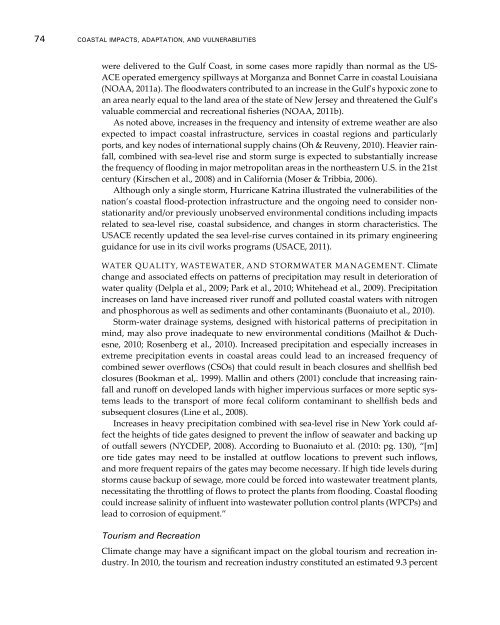Coastal Impacts, Adaptation, and Vulnerabilities - Climate ...
Coastal Impacts, Adaptation, and Vulnerabilities - Climate ...
Coastal Impacts, Adaptation, and Vulnerabilities - Climate ...
You also want an ePaper? Increase the reach of your titles
YUMPU automatically turns print PDFs into web optimized ePapers that Google loves.
74 <strong>Coastal</strong> <strong>Impacts</strong>, <strong>Adaptation</strong>, <strong>and</strong> <strong>Vulnerabilities</strong>were delivered to the Gulf Coast, in some cases more rapidly than normal as the US-ACE operated emergency spillways at Morganza <strong>and</strong> Bonnet Carre in coastal Louisiana(NOAA, 2011a). The floodwaters contributed to an increase in the Gulf’s hypoxic zone toan area nearly equal to the l<strong>and</strong> area of the state of New Jersey <strong>and</strong> threatened the Gulf’svaluable commercial <strong>and</strong> recreational fisheries (NOAA, 2011b).As noted above, increases in the frequency <strong>and</strong> intensity of extreme weather are alsoexpected to impact coastal infrastructure, services in coastal regions <strong>and</strong> particularlyports, <strong>and</strong> key nodes of international supply chains (Oh & Reuveny, 2010). Heavier rainfall,combined with sea-level rise <strong>and</strong> storm surge is expected to substantially increasethe frequency of flooding in major metropolitan areas in the northeastern U.S. in the 21stcentury (Kirschen et al., 2008) <strong>and</strong> in California (Moser & Tribbia, 2006).Although only a single storm, Hurricane Katrina illustrated the vulnerabilities of thenation’s coastal flood-protection infrastructure <strong>and</strong> the ongoing need to consider nonstationarity<strong>and</strong>/or previously unobserved environmental conditions including impactsrelated to sea-level rise, coastal subsidence, <strong>and</strong> changes in storm characteristics. TheUSACE recently updated the sea level-rise curves contained in its primary engineeringguidance for use in its civil works programs (USACE, 2011).Water QUALITY, WASTEWATER, <strong>and</strong> STORMWATER MANAGEMENT. <strong>Climate</strong>change <strong>and</strong> associated effects on patterns of precipitation may result in deterioration ofwater quality (Delpla et al., 2009; Park et al., 2010; Whitehead et al., 2009). Precipitationincreases on l<strong>and</strong> have increased river runoff <strong>and</strong> polluted coastal waters with nitrogen<strong>and</strong> phosphorous as well as sediments <strong>and</strong> other contaminants (Buonaiuto et al., 2010).Storm-water drainage systems, designed with historical patterns of precipitation inmind, may also prove inadequate to new environmental conditions (Mailhot & Duchesne,2010; Rosenberg et al., 2010). Increased precipitation <strong>and</strong> especially increases inextreme precipitation events in coastal areas could lead to an increased frequency ofcombined sewer overflows (CSOs) that could result in beach closures <strong>and</strong> shellfish bedclosures (Bookman et al,. 1999). Mallin <strong>and</strong> others (2001) conclude that increasing rainfall<strong>and</strong> runoff on developed l<strong>and</strong>s with higher impervious surfaces or more septic systemsleads to the transport of more fecal coliform contaminant to shellfish beds <strong>and</strong>subsequent closures (Line et al., 2008).Increases in heavy precipitation combined with sea-level rise in New York could affectthe heights of tide gates designed to prevent the inflow of seawater <strong>and</strong> backing upof outfall sewers (NYCDEP, 2008). According to Buonaiuto et al. (2010: pg. 130), “[m]ore tide gates may need to be installed at outflow locations to prevent such inflows,<strong>and</strong> more frequent repairs of the gates may become necessary. If high tide levels duringstorms cause backup of sewage, more could be forced into wastewater treatment plants,necessitating the throttling of flows to protect the plants from flooding. <strong>Coastal</strong> floodingcould increase salinity of influent into wastewater pollution control plants (WPCPs) <strong>and</strong>lead to corrosion of equipment.”Tourism <strong>and</strong> Recreation<strong>Climate</strong> change may have a significant impact on the global tourism <strong>and</strong> recreation industry.In 2010, the tourism <strong>and</strong> recreation industry constituted an estimated 9.3 percent
















